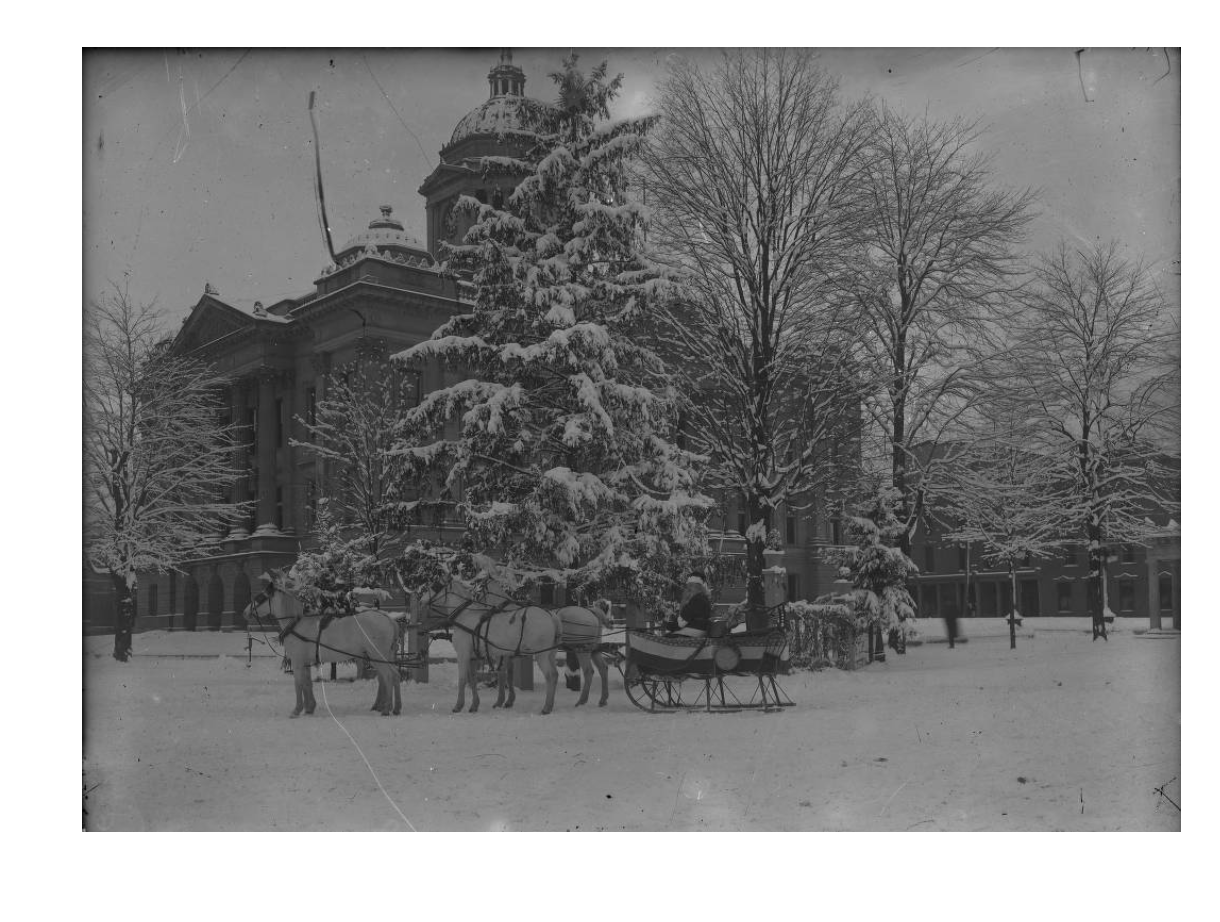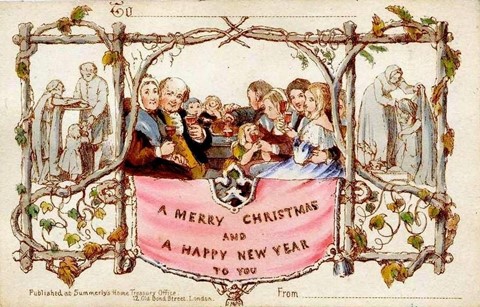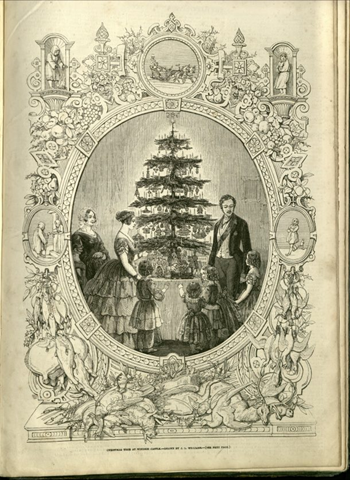Ohio Holiday Traditions
By Katie Nowack and Andrew Hall, Ohio History Connection

Christmas Tree and Sleigh in Front of Wyandot County Courthouse photo, Upper Sandusky Ohio, c. 1910 from Ohio Memory.org
Much of what we consider holiday traditions today can be traced back to the Victorian Era. This period in time (1837-1901) is named for the reign of Queen Victoria of England – and Queen Victoria was the global trendsetter of her day. Traditions including the Christmas tree, sending holiday cards, and celebrating with your community became popular during this time, and that is the case for many people living in Ohio in the Victorian Age.
Ohioans in the 1800s came from a variety of places; many Black and White settlers moved into the area as farmers or tradespeople, making the state an invaluable resource for crop production and skillfully crafted items. Immigrants from Germany, Ireland, as well as settlers from Kentucky and Pennsylvania and freedom-seekers from the South traveled to Ohio, bringing traditions with them while establishing new ones. Below, we’ll share some traditions we interpret through the Ohio History Connection’s many holiday programs.
Christmas Cards
Christmas cards have been for sale since 1846, and that is due to Sir Henry Cole, a wealthy aristocrat with a lot of friends and a cramped writing hand! Instead of writing Christmas letters to his friends that year, he commissioned a picture greeting card to be made by an artist friend, John Clacott Horsley. The image showed a cheerful family group toasting to the health of the receiver of the card, who are flanked by scenes of Christmas charity, with the inscription ‘A Merry Christmas and a Happy New Year to You’. Each card was hand tinted, adding to the personalized effect. By the 1860s the idea of sending cards to friends at Christmas had really caught on, and even local businesses sent out holiday greeting cards as advertisements for their consumers.
Photo courtesy of the Victoria and Albert Museum online collection.
It was Prince Albert (Queen Victoria’s husband) who popularized the Christmas tree in Britain and North America. Until then trees had been a German tradition and was not yet a feature of the typical middle-class English or American Christmas. Albert brought the custom with him from his homeland and in 1848, the Illustrated London News published a lithograph showing the Royal Family gathered around a candlelit, decorated tree. People in England and the United States were quick to incorporate the custom into their own homes.
Evergreens and Christmas Trees
It was Prince Albert (Queen Victoria’s husband) who popularized the Christmas tree in Britain and North America. Until then trees had been a German tradition and was not yet a feature of the typical middle-class English or American Christmas. Albert brought the custom with him from his homeland and in 1848, the Illustrated London News published a lithograph showing the Royal Family gathered around a candlelit, decorated tree. People in England and the United States were quick to incorporate the custom into their own homes.

Christmas Supplement to the print featured in the Illustrated London News, wood engraving, 1848, courtesy of the Victoria and Albert Museum.
By the 1880s in America there were more than 600 Christmas tree dealers. The first U.S. President to have a Christmas tree in the White House was Franklin Pierce in 1856.
Early Victoria trees were decorated with pinecones, dried fruits, nuts, berries, strings of popcorn, paper chains, and perhaps some small, homemade gifts. Hand-dipped candles were placed carefully on branches, and a star was placed on top. Later Victorian trees were much fancier. These trees were shown with candles, miniature toys, fans, musical instruments, books and elaborate decorations. Some were made in the United States, but many were made in Germany. While these were available, their high cost usually kept many households from purchasing them, and they still relied on homemade decorations. These included strung holly berries, popcorn and cranberries, paper flower bouquets, strings of beads, and paper star decorations. By the 1890s Christmas ornaments were arriving from Germany and Christmas tree popularity was on the rise around the U.S. It noted that Europeans used small trees about four feet in height, while Americans liked their Christmas trees to reach from floor to ceiling.
Tree Lights Go Electric

Ad for GE Christmas Lights, c. 1903- Image Courtesy of BoweryBoysHistory.com
People have been lighting Christmas trees with candles since the early 1800s. But candles, while pretty, are dangerous. On December 22nd, 1882, Edward Johnson, vice president of the Edison Electric Light Company, displayed the first electrically illuminated Christmas tree in the parlor of his New York City home. The tree featured eighty hand-wired red, white and blue light bulbs, which, according to a reporter from the Detroit Post and Tribune, were each “as large as an English walnut” and the tree sat on a motorized box that rotated it “some six times a minute.” In 1890 they took them to the marketplace, publishing a 28-page brochure about “Edison miniature lamps for Christmas trees” and placing ads for the product in popular magazines. In 1895 Grover Cleveland illumined his tree with electricity in the White House.
Sources:
“The First Christmas Card” from the Victoria and Albert Museum online article collection, https://www.vam.ac.uk/articles/the-first-christmas-card
“The History of the Christmas Card” from Smithsonian Magazine, https://www.smithsonianmag.com/history/history-christmas-card-180957487/
“Our History: Cincinnati Rabbis to Thank for Popularizing Hanukkah” from The Cincinnati Enquirer Online, published Dec 7 2018 https://www.cincinnati.com/story/news/2018/12/07/hanukkah-how-cincinnati-rabbis-popularized-jewish-holiday/2222127002/
“Hanukkah and Christmas in America” from the Jack Miller Center online, https://jackmillercenter.org/hanukkah-christmas-america-1/
“The Magic of the Tree” article by Frances Willis from the National Art Library, originally posted December 2020- featured on the Victoria and Albert website https://www.vam.ac.uk/blog/design-and-society/the-magic-of-the-tree
“Who Invented Electric Christmas Lights?” from the Library of Congress Everyday Mysteries online article collection, https://www.loc.gov/everyday-mysteries/technology/item/who-invented-electric-christmas-lights/
Ohio Memory:
- “Christmas Tree at Kinley Home” photo, Sandusky Ohio, early 1900s https://ohiomemory.org/digital/collection/p267401coll32/id/19799/rec/7
- “Christmas Tree and Child” photo, Milan Ohio, 1890s https://ohiomemory.org/digital/collection/p16007coll91/id/8548/rec/3
- “Christmas Tree and Sleigh in Front of Wyandot County Courthouse” photo, Upper Sandusky Ohio, c. 1910 https://ohiomemory.org/digital/collection/p267401coll32/id/15795/rec/5
- “L. Lesquereux Christmas Advertisement” Lithopolis OH, c. 1899 https://ohiomemory.org/digital/collection/p267401coll32/id/21955/rec/12